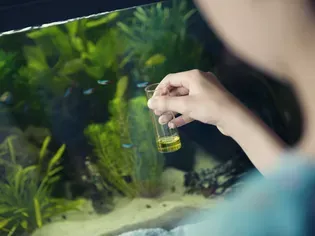Aquarium Water Parameters to Control for Healthy Fish
Updated on 04/26/24

Unlocking the Secrets to Pristine Aquarium Waters: A Comprehensive Guide to Essential Water Parameters for Thriving Fish
Creating a thriving habitat for your beloved fish requires meticulous attention to their aquatic environment. Among the most crucial aspects of aquarium keeping is maintaining optimal water parameters, ensuring the well-being and longevity of your finned companions. This extensive guide delves into the essential water parameters you need to monitor and control to foster a healthy and vibrant aquarium ecosystem.
1. Temperature: The Foundation of Metabolic Harmony
Temperature plays a pivotal role in the physiological functions of fish. Each species has a preferred temperature range within which they thrive. Maintaining the appropriate temperature is crucial for optimal metabolism, growth, reproduction, and overall health.
Example: Tropical fish, such as guppies and tetras, prefer warm waters between 75-82°F (24-28°C), while goldfish and koi are more comfortable in cooler waters of 60-70°F (16-21°C).
2. pH: The Balancing Act of Acid and Base
pH measures the acidity or alkalinity of water, affecting various biological processes in fish. Maintaining a stable and appropriate pH is essential for healthy fish growth, immune function, and reproduction.
Example: Most tropical fish prefer a neutral pH of around 7.0, while African cichlids thrive in slightly alkaline waters with a pH of 7.5-8.5.
3. Ammonia: The Unseen Enemy
Ammonia, a byproduct of fish waste, is highly toxic to fish even in small concentrations. Regular monitoring and control of ammonia levels are crucial to prevent fish stress, illness, and death.
Example: Ammonia levels should be kept below 0.25 ppm (parts per million) for most fish species. Regular water changes and the use of biological filtration systems help remove ammonia from the aquarium.
4. Nitrite: The Intermediate Threat
Nitrite is an intermediate product in the nitrogen cycle, which converts ammonia into nitrates. While less toxic than ammonia, nitrite can still be harmful to fish, particularly young and sensitive species.
Example: Nitrite levels should be kept below 0.5 ppm. Biological filtration systems help convert nitrite into less harmful nitrates.
5. Nitrate: The Less Harmful Byproduct
Nitrate is the final product of the nitrogen cycle, posing less of a threat to fish than ammonia or nitrite. However, elevated nitrate levels can contribute to algae growth and, in extreme cases, can cause fish stress and health issues.
Example: Nitrate levels below 20 ppm are generally considered safe for most fish species. Regular water changes and the use of nitrate-removing filtration media can help keep nitrate levels in check.
6. Dissolved Oxygen: The Lifeline of Aquatic Respiration
Dissolved oxygen (DO) measures the amount of oxygen available in the water, crucial for fish respiration. Maintaining adequate DO levels ensures proper oxygen uptake by fish and prevents respiratory distress.
Example: Most fish require a DO level of at least 5 ppm to thrive. Air pumps, water fountains, and live plants can help increase DO levels in the aquarium.
7. Hardness: The Mineral Matrix
Water hardness refers to the concentration of dissolved minerals, primarily calcium and magnesium. Different fish species have varying hardness preferences, affecting their overall health and development.
Example: Soft water fish, such as discus and neon tetras, prefer low hardness levels, while hard water fish, like African cichlids and mollies, thrive in higher hardness waters.
8. Alkalinity: The pH Buffer
Alkalinity measures the water's capacity to neutralize acids, helping to maintain a stable pH. Proper alkalinity levels are crucial for healthy fish growth and prevent sudden pH fluctuations.
Example: Most fish prefer an alkalinity range of 50-150 ppm. Buffer systems can be added to the aquarium to maintain stability.
9. Chlorine and Chloramine: The Unwelcome Guests
Municipal water often contains chlorine or chloramine as disinfectants, which can be toxic to fish. Proper water conditioning is essential to remove these chemicals before adding water to the aquarium.
10. Heavy Metals: The Silent Threat
Heavy metals, such as copper and lead, can be introduced into aquarium water through various sources and pose a significant threat to fish health. Regular testing and mitigation measures are crucial.
Conclusion: Maintaining Aquarium Water Parameters for Thriving Fish
Maintaining optimal water parameters is the cornerstone of successful aquarium keeping. By understanding the essential parameters and implementing proper monitoring and control measures, you can create a healthy and thriving environment for your beloved fish. Regular testing, water changes, filtration systems, and proper water conditioning ensure that your aquatic pets enjoy a long and happy life in your care.
Explore More Pets

Freshwater Aquarium Filters
How to Deal With Cloudy Aquarium Water

Saltwater Aquarium Filters
How Do You Remove Chloramines From Tap Water?

Freshwater Aquariums & Habitat
Can I Keep My Koi Fish Inside?

Saltwater Aquariums & Habitat
14 Best Floating Plants for Your Aquarium

Freshwater Fish Health
How to Treat Ich on Freshwater Fish

Saltwater Fish Health
Fin Rot in Aquarium Fish

Freshwater Aquarium Filters
How to Do Aquarium Water Changes

Saltwater Fish Health
How Do Fish Get Parasites?